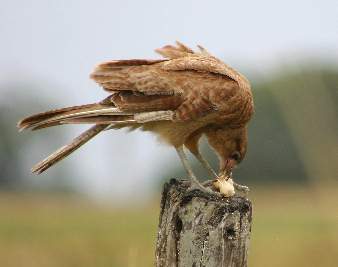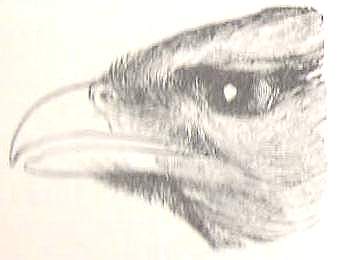
Picture of Chimango Caracara (Milvago chimango)

Diagram of head of Caracara (Milvago)
|
The Caracara is a South American bird, so called
by the natives of Brazil, first described and illustrated by Marcgrave
in 1648 (Historia Natural do Brasil, page 211). In 1782 it became
the Falco tharus of Molina (Sagg. Stor. Nat. Chili, p. 264),
and is now in the early twenty first century the Polyborinae subfamily
within the Falconidae family of modern ornithology.
The Caracaras are a small group of birds, which
have a Falconine structure and Vulturine habits, amongst other peculiarities.
These birds with some others, are the "Carrion-hawks" which were frequently
mentioned in Darwin's Voyage.
It is worthy of remark that, according to the 19th
Century writer Mr. Hudson (ut supra), after the introduction of
large herds of cattle to the plains of South America the abundance of food
supplied by their carcases resulted in a great increase in the numbers
of these birds.
They are large birds, 40
to 60 cm with a wingspan of approximately 130 cm. It is not a specialized
predator but is mainly an opportunist and scavenger, feeding on insects,
amphibians, rodents and any other easy prey. They have long legs, and all
the members of this group are said to walk or run on the ground - a peculiarity
not possessed in perfection by any of the other Falconine birds with which
they are generally associated.
The most well-known type
is the Crested Caracara (Polyborus plancus) who is resident from
Southern USA to South America. The bare skin around the eyes of the Crested
Caracara can change colour in the space of a few seconds. The call
of the Crested Caracra is a low rattle. On the Falkland Islands the
Southernmost type lives, this being the obscure Falkland-caracara
(Phalcoboenus
australis).
|





